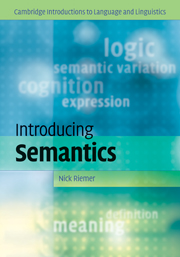Book contents
- Frontmatter
- Contents
- Note to the reader
- 1 Meaning in the empirical study of language
- 2 Meaning and definition
- 3 The scope of meaning I: external context
- 4 The scope of meaning II: interpersonal context
- 5 Analysing and distinguishing meanings
- 6 Logic as a representation of meaning
- 7 Meaning and cognition I: categorization and cognitive semantics
- 8 Meaning and cognition II: formalizing and simulating conceptual representations
- 9 Meaning and morphosyntax I: the semantics of grammatical categories
- 10 Meaning and morphosyntax II: verb meaning and argument structure
- 11 Semantic variation and change
- Glossary
- References
- Index
7 - Meaning and cognition I: categorization and cognitive semantics
Published online by Cambridge University Press: 05 June 2012
- Frontmatter
- Contents
- Note to the reader
- 1 Meaning in the empirical study of language
- 2 Meaning and definition
- 3 The scope of meaning I: external context
- 4 The scope of meaning II: interpersonal context
- 5 Analysing and distinguishing meanings
- 6 Logic as a representation of meaning
- 7 Meaning and cognition I: categorization and cognitive semantics
- 8 Meaning and cognition II: formalizing and simulating conceptual representations
- 9 Meaning and morphosyntax I: the semantics of grammatical categories
- 10 Meaning and morphosyntax II: verb meaning and argument structure
- 11 Semantic variation and change
- Glossary
- References
- Index
Summary
CHAPTER PREVIEW
This chapter considers meaning from the perspective of the cognitive operations which the mind can be hypothesized to perform in using language. We begin by introducing the idea that words in natural language can be seen as categories, and discuss two different models of the way categories work, the classical view of categorization and the prototype view (7.1), exploring the advantages and problems of each. We then discuss cognitive approaches to meaning, which developed out of the prototypical model of categorization. These approaches have introduced a rich model of the cognitive architecture underlying language (7.2).
The semantics of categorization
Categorization is an important topic in semantics because language can be seen as means of categorizing experience. A word like flower, for example, categorizes an indefinitely large number of different entities in the world as all examples of a single kind of thing, the category FLOWER. The actual types of flower vary widely – think of the difference between a tulip, a carnation and a sunflower – but these differences in no way affect the categorization of all types as flowers. The same is true of other lexical categories. The types of action I might describe by saying I am writing, for example, cover a wide range: filling in a form with a biro, typing on a keyboard, drawing letters in freshly poured concrete with a stick, and sitting in front of a blank sheet of paper with a pen, wondering how to begin a sentence. These outward differences are all glossed over by the verb write, which can be used for all of these activities indifferently.
- Type
- Chapter
- Information
- Introducing Semantics , pp. 223 - 260Publisher: Cambridge University PressPrint publication year: 2010



